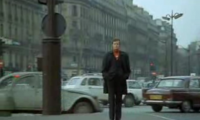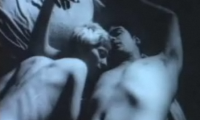Rainer Werner Fassbinder, “The Bitter Tears of Petra von Kant” (1972)
The message read: “Do not ever watch your torture porn in my house again.” Sitting in my living room, watching Lars von Trier’s “Dogville” with a friend, I received the enraged text from my boyfriend, glowering at the kitchen table.
A couple weeks previous we were in this same conflicted configuration—on opposite sides of the house—as I watched the first two episodes of Rainer Werner Fassbinder’s epic “Berlin Alexanderplatz” (1980).
Fassbinder and von Trier are my boyfriend’s oft-cited examples of the kind of soul-destroying filmmaking he thinks I am exclusively—nay, pathologically—interested in, nothing but pure emotional cruelty or, to borrow from his colorful text message, “torture porn.”
Lars Von Trier, “Dogville” (2003)
Less than a year into our relationship, we went through a similar showdown after attending the Montreal premiere of von Trier’s “Dancer in the Dark” at the Festival du Nouveau Cinéma in 2000. Arriving early to get prime seats, I ecstatically endured—foolishly, with boyfriend in tow—its sacrifice of poor, cute, blind Björk (as Selma) on the alter of von Trier’s small-town American life, a steel trap where the weak destroy the weak and “simple” values engender the greatest monstrosities.
The packed theater was wracked with tears by film’s end, following possibly one of the most gruesome scenes in cinema: Selma’s hanging.
Lars von Trier, “Death Sentence” (Dancer in the Dark, 2000)
Deeply satisfied with the gut-wrenching piece of cinematic brilliance I’d just witnessed, I gathered my coat and bag and left the auditorium. Boyfriend, however, was immobile: crippled by sobs, weeping openly in a messy, messy way.
The story goes that I looked at him with great disgust, and asked incredulously, “are you ok?!” The ugly crying continued down the street to the Metro station and, combined with my stoic WASP discomfort, created a volatile context for a heated discussion about emotional investment in cinema.
I should note that this heated debate flared up again a week later, when I very stupidly dragged boyfriend to see “Requiem for a Dream” (2000), chosen by Empire as the #1 most depressing film of all time. He stormed out of the theater during the memorably nauseating climax that cross-cuts shots of amputation, electroshock and degradation. Oops.
Ensconced in a haze of self-satisfied superiority, I pride myself on my capacity to both be sincerely emotionally affected by a film and maintain a cold, intellectual gaze on it at the same time. This is partly the spoils of several years of academic film studies, where one learns that no matter how disturbing or debased a film may be, each is an object worthy of critical engagement.
While a practicing art critic, my boyfriend is incapable of watching any film about the Holocaust—even the comedies—or any film that is overly upsetting, particularly unflinching portrayals of physical or emotional abuse (with the exception of Hollywood blockbusters: the famed cock-and-ball-torture scene of “Casino Royale” (2006) for example is A-OK).
A recent, particularly vicious fight over “Synecdoche, New York” (2008)—which boyfriend defined as “pure misery” and I found mesmerizing—seemed to get us closer to the heart of the matter. My defense was that the film’s formal experimentation was so dazzling and labyrinthine that it transcended the incredible despair suffered by all the characters. Basically, in my mind if the on-screen suffering is for some sort of greater good—an aesthetic achievement or ethical provocation—it is worth enduring.
I think that Fassbinder and von Trier seem like the worst of the worst to boyfriend because they stylize human misery to extreme degrees and to allegorical ends. They both advocate for emotional cruelty as revelatory and potentially curative, with the image of one individual soul tormenting or destroying another the most visceral metaphor for greater political or existential conflicts.
Peter W. Jansen, “Interview Rainer Werner Fassbinder” (1978)
Somehow I can’t accept that his feelings are facts (why else, gentle Ryeberg readers, would I be forcing you to read about our private spats in this very post?). Maybe despite my proclaimed atheism, I’m still carrying Catholic baggage that sees suffering as somehow redemptive. Maybe I get off on my righteous highbrow outrage at his over-sensitivity. Maybe I’m just more of a masochist than he is…
– Jon Davies









